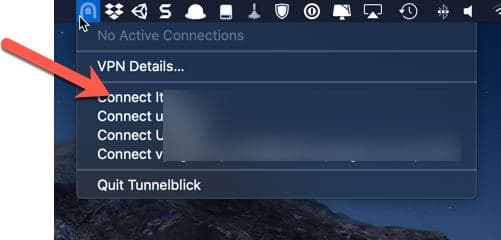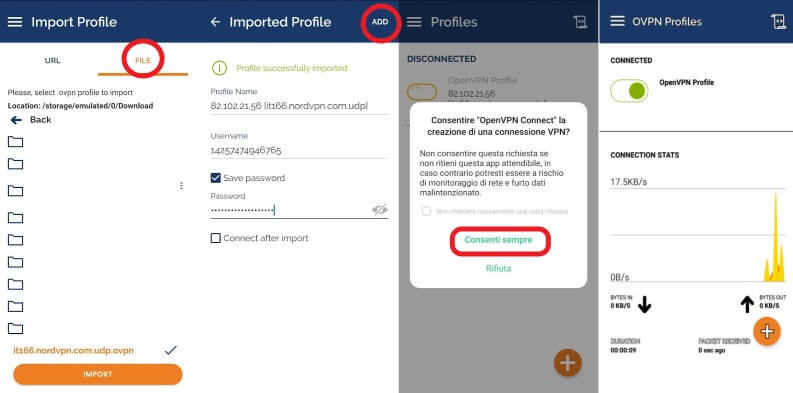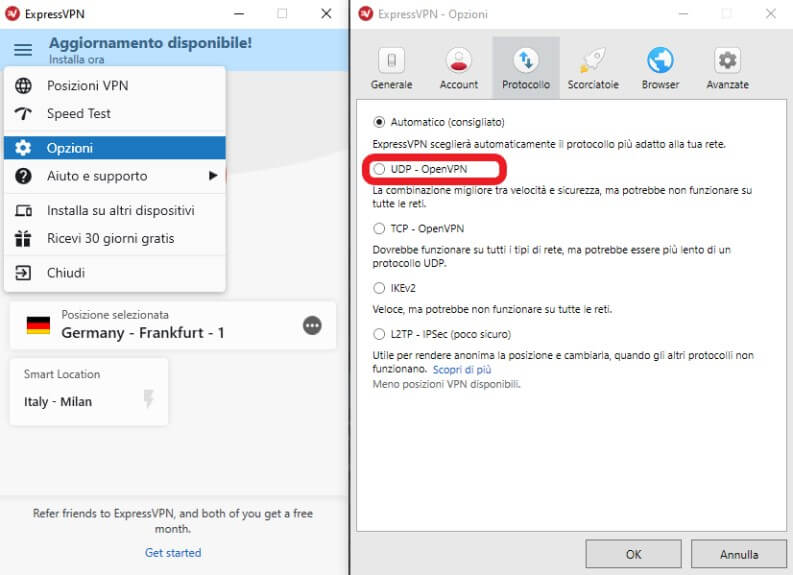How to set up OpenVPN on computer or phone
– Learn these tips and tricks on how to use your devices in a much easier way as well as solved some of your common problems that are difficult.
We’ve already talked a lot about VPNs on these pages, those reti private that allow you to navigate safely and maintaining anonymity.
One of the most popular and secure VPN security protocols is OpenVPN. Its implementation requires the presence of a customer (open source to download and install on the system).
A client is a program, which takes care of taking a user’s traffic and routing it along a encrypted tunnel to a server.
Why is OpenVPN important?
It is a very popular security protocol because it is open source and easily implemented and improved. Being open source makes the code inspectable by anyone with the skills and expertise (hackers or security experts).
According to Snowden, the famous NSA collaborator who revealed the massive surveillance put in place by the agency, OpenVPN would be theonly truly secure protocol. In fact, since the code is freely available, someone would have noticed over the years the presence of some backdoor or vulnerability.
This protocol supports many ciphers, including the popular AES with cryptographic key a 256 bit, which guarantees a level of military security.
What are the best VPNs that support OpenVPN?
To date, no serious VPN service cannot fail to support Open VPN. As we explained above, this is a fundamental protocol for the entire industry.
If you want services that have implemented well Open VPN ensuring security and speed we advise you to contact:
- CyberGhost
It is a VPN that does not store user data, definitely worth considering. It offers excellent performance and an obsessive attention to safety. Find out all in our full CyberGhost VPN trial. - NordVPN
It is a service with an excellent quality level, excellent speed and competitive prices. You can learn more by checking out NordVPN’s full review. - Surfshark
Always an excellent service with a very competitive cost (lower than the aforementioned VPNs), which combines a solid no-log policy with the use of the best connection protocols. You can find out more about this service by consulting the SurfShark trial. - ExpressVPN
Considered by many to be the best service. In our test it is confirmed to be a VPN that supports all security protocols, guarantees privacy and anonymity. In any case, the quality is indisputable and for this you pay dearly. Check out our Express VPN trial.
All paid VPN services offer implementations of the OpenVPN protocol. Before choosing one, you are encouraged to check out our constantly updated ranking of the best VPNs.
How do you use OpenVPN?
Most services offer it as the default connection protocol. As we said, to use it you need a client that takes care of routing traffic through the tunnel. The simplest and most practical way to connect via OpenVPN is just that of use the client provided by the service and for all platforms.
How to use the OpenVPN clients offered by VPNs
The most common paid VPN services offer their own pre-configured clients for Windows, macOS, iOS and Android and the best ones also for the Linux operating system.
Once installed, just click or tap to choose the server and make the connection. In every service client we have ever tried, we can make sure that the protocollo OpenVPN is the one used, simply by going to Settings (or Options) and then in the Security> Protocol section or in that Connection.
Once set up, every time we connect to a server on the list, we will automatically be connected via this protocol.
If, on the other hand, you are geek or want to have more control, you can avoid using the default clients and install the generic OpenVPN client. It can be the solution if you want to set up your own VPN network between home and office. Read on to find out how to do it on various operating systems.
Set up OpenVPN on Windows 10
The software to use in this case is OpenVPN GUI and you can take it directly from this page. Choose the Windows version from the appropriate table.
Along with this, you need to download the configuration package that each service dedicates to OpenVPN. If, on the other hand, you are configuring the server part (in the office or at home), you will have created the configuration manually. In any case, setting up a VPN server is not the subject of this guide (but it will be in the future, so we invite you to continue following us).
Generally, OpenVPN configurations can be found by going to the VPN network site: for example, on ExpressVPN, simply log in with your account credentials and from the download page select “Set Up on More Devices” and then press on “Manual Config” and on the “Open VPN” tab; from here you can choose the server to use and you can easily download the ready-made configuration files. The page will also show Username and Password that you will need to enter later when requested in the procedure.
Then you need to install the OpenVPN GUI by clicking on the executable “OpenVPN-install”. For safe installation, just follow the procedure, clicking when asked on “Next”, “Agree” and “Install”.
At the end of the installation, the OpenVPN GUI icon will appear on the desktop; click on it with the right button and then press with the left on the item “Open file path”. Then in the address bar click on “OpenVPN” to reach the “Program Files OpenVPN” folder. Here you need to enter the “config” folder and insert the configuration files with .ovpn extension, which you downloaded earlier.
It can be launched OpenVPN GUI and its icon will always appear at the bottom right. It is possible to click on the icon, go to the item connect and choose the server. During the connection procedure you will be asked for your username (Username) and the keyword (Password). When the connection with the server is established, we will be notified by a notification.
If you want to know more about the procedure for ExpressVPN, just go to the dedicated page. All the other big VPN services have similar pages.
Set up OpenVPN on macOS
For manual configuration, download the OpenVPN Connect client from the OpenVPN page or, the solution we recommend, the excellent Tunnelblick.
With Tunnelblick you can manage various configurations and keep them ready to connect to different VPN networks via the OpenVPN protocol. For example, you might keep the office setup, one setup with CyberGhost, and yet another setup with Express VPN. The advantage of this solution is therefore to keep everything on the client and immediately choose which “tunnel” to use.

Once you get a ready configuration based on the OpenVPN protocol, import it into the application. The configuration in .ovpn format can be obtained from the various suppliers (always NordVPN, ExpressVPN, etc.) or from the network administrator of your office.
Configurare OpenVPN su Android
Even on the widespread Google platform for smartphones, tablets (and TV boxes), the most straightforward way is to install the client of the chosen service. The service client will also already be a pre-configured OpenVPN client. You can download the VPN client directly by looking for its name on the Play Store and there is no serious service that does not have an App.
If you want to try your hand at manual configuration you can refer to the guides that each service dedicates to the topic. For example, we will follow the procedure proposed by NordVPN.
In this case, the configuration files are located at this address and here you have to choose in the appropriate drop-down menu, the country of the server we want to connect to and, under its flag, click on “Show available protocols” and then on “Download config” next to “Open VPN UDP“.
This will download a configuration file in .ovpn format which will be useful to us later.
Then, download the app OpenVPN Connect, free directly from the Play Store. Once installation is complete, start the App and the “Import Profile” tab will appear at the first start. Then click on “File”. When the app asks for permission to access the memory, choose “Allow”.
Then open the configuration file in .ovpn format (downloaded previously) and that will surely be found in the “Download” folder.
On the “Imported Profile” screen, check “Save password” and then enter the username and password of the service. Note: These are usually not the same ones you use to access the site but are found in the VPN Service Dashboard. Just go to this page and then select “Dashboard” and “NordVPN”. In the “Advanced configurations” box you will find the credentials you are looking for.
Once you have entered everything, you can finish the configuration by pressing the “Add” button at the top.
At this point the profile will be ready for use. As soon as you click on the toggle (the on / off switch), the system will ask you if you want to allow the creation of a VPN connection. You will have to press on “Always allow”. At this point you will be prompted for a certificate, click on the “Continue” button.
If the connection is successful, the button will turn green and the graph of the traffic exchanged will appear. You can disconnect by pressing the switch next to the server name again.
I will configure OpenVPN on your iOS / iPadOS
On your iPhone smartphone or iPad tablet, you can use the generic Open VPN client available as an App to be installed via the App Store: Download OpenVPN Connect App Store.
You agree to give all permissions where required because the client needs to make the necessary changes to get your connections out of the VPN tunnel. Also in this case, as in the Android version (see above) it is necessary to obtain the configuration to be imported on OpenVPN Connect. Look for the configuration file on your VPN provider’s website.
OpenVPN it is a free, open source and extremely flexible protocol. We have seen how it is used in a very simple way on the operating systems of the computers and smartphones we own; the use and convenience of this type of protocol does not end there: it is possible to use it on the most advanced routers or directly on the NAS / mini-servers we have at home. The only thing we need is the configuration file to be imported to the various clients that support the OpenVPN protocol.















